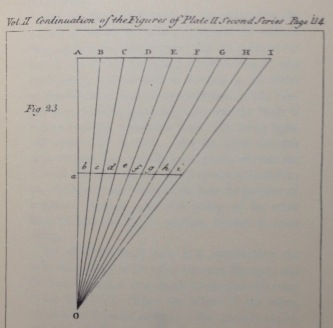This is the third of eleven Letters of Euler I will rewrite and post on the subject of infinitesimals (the infinitely small), an idea that is fundamental to a good understanding of calculus. Click here to read the previous letter.
Letter IX. Whether this Divisibility in Infinitum Takes Place in Existing Bodies?
It is, then, a completely established truth, that extension* is divisible to infinity, and that it is impossible to conceive parts so small as to be unsusceptible of farther division. Philosophers accordingly do not impugn this truth itself, but deny that it takes place in existing bodies. They allege, that extension, the divisibility of which to infinity has been demonstrated, is merely a chimerical object, formed by abstraction; and that simple extension, as considered in geometry, can have no real existence.
*if a body has extension, that means you can measure it (length, mass, etc.).
Here they are in the right; and extension is undoubtedly a general idea, formed in the same manner as that of man, or of tree in general, by abstraction; and as man or tree in general exists not, no more does extension in general exist. You are perfectly sensible, that individual beings alone exist, and that general notions are to be found only in the mind; but it cannot therefore be maintained that these general notions are chimerical; they contain, on the contrary, the foundation of all our knowledge.
Whatever applies to general notion, and all the properties attached to it, of necessity take place in all the individuals comprehended under that general notion. When it is affirmed that the general notion of man contains an understanding and a will, it is undoubtedly meant, that every individual man is endowed with those faculties. And how many properties do these very philosophers boast of having demonstrated as belonging to substance in general, which is surely an idea as abstract as that of extension; and yet they maintain, that all these properties apply to all individual substances, which are all extended. If, in effect, such a substance had not these properties, it would be false that they belonged to substance in general.
If then bodies, which infallibly are extended beings, or endowed with extension, were not divisible to infinity, it would be likewise false, that divisibility in infinitum is a property of extension. Now those philosophers readily admit that this property belongs to extension, but they insist that it cannot take place in extended beings. This is the same thing with affirming, that the understanding and will are indeed attributes of the notion of man in general; but that they can have no place in individual men actually existing.
Hence you will readily draw this conclusion: if divisibility in infinitum is a property of extension in general, it must of necessity likewise belong to all individual extended beings; or if real extended beings are not divisible to infinity, it is false that divisibility in infinitum can be a property of extension in general.
It is impossible to deny that the one or the other of these consequences without subverting the most solid principles of all knowledge; and that philosophers who refuse to admit divisibility in infinitum in real extended beings, ought as little to admit it with respect to extension in general; but as they gran this last, they fall into a glaring contradiction.
You need not to be surprised at this; it is a failing from which the greatest men are not exempt. But what is rather surprising, these philosophers, in order to get rid of their embarrassment, have thought proper to deny that body is extended. They say, that it is only an appearance of extension which is perceived in bodies, but that real extension by no means belongs to them.
You see clearly that this is merely a wretched cavil, by which the principal, and the most evident property of body is denied. It is an extravagance similar to that formerly imputed to the Epicurean philosophers, who maintained that every thing which exists in the universe is material, without even excepting the gods whose existence they admitted. But as they saw that these corporeal gods would be subjected to the greatest difficulties, they invented a subterfuge similar to that of our modern philosophers, alleging, That the gods had not bodies, but as it were bodies, (quasi corpora) and that they had not senses, but senses as it were; and so of all the members. The other philosophical sects of antiquity made themselves abundantly merry with these quasi-corpora and quasi-sensus; and they would have equal reason, in modern times, to laugh at the quasi-extension which our philosophers ascribe to body; this term quasi-extension seems perfectly well to express that appearance of extension, without being so in reality.
Geometricians, if they meant to confound them, have only to say, that the objects whose divisibility in infinitum they have demonstrated, were likewise only as it were extended, and that accordingly all bodies extended as it were, were necessarily divisible in infinitum. But nothing is to be gained with them; they are resolute to maintain the greatest absurdities rather than acknowledge a mistake. You must have remarked, that this is the character of almost all scholars.*
3rd May, 1761
*NOTE: In 2017, beware of the scholar who claims that, in nature, what we see is merely quasi-design, the appearance of design. Making such an absurd statement is evidence of a stubborn refusal to acknowledge the Designer.

A mother humpback whale and calf. That the calf is a scale model of it’s mother is no accident or mere “appearance of design.” It is clear evidence of design, and their Designer.
 s
s 
